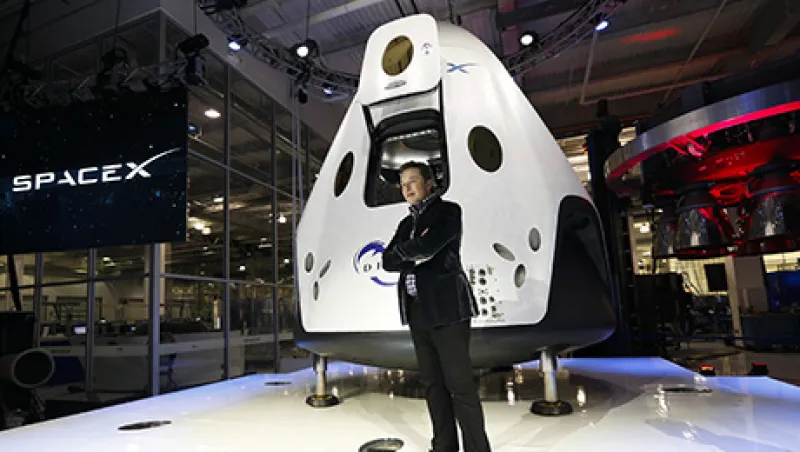These days it seems almost a foregone conclusion that the science fiction of the past generation should come true. The writer Ray Bradbury made a living and his fame teaching American readers to dream about Mars. He made the Red Planet a destination for our dreams, for fantasies of life beyond the horizons of our own planet — and challenged readers by twisting those fantasies toward the horrific. In the short story “Mars Is Heaven!” a troop of astronauts sent to Mars encounters what appears to be a lost paradise of friends and family members once known on Earth — the result of that encounter is the massive slaughter of the entire crew by the aliens.
Well, what more often comes true these days is the science part of science fiction, sans the shocking or gruesome dramatic turns. The matter-of-factness with which Hawthorne, California–based SpaceX has gone about announcing its plans to establish a permanent colony on Mars has been almost stunning: According to SpaceX, no new technology will need to be invented to transport humans to the Red Planet and leave them there, able to sustain themselves, indefinitely. All time lines for the construction and testing of shuttles, landing capsules and habitats have been developed out of thorough conversations with engineers at a range of partners that have demonstrated the ability to build and integrate all required components.
Indeed, there is little doubt that SpaceX can deliver on a Mars colony — NASA seems to think the company’s technology is worth banking a great deal of money on. In September, NASA awarded SpaceX and Boeing $6.8 billion in contracts to begin to build the first private space shuttles to the International Space Station (ISS) orbiting Earth.
SpaceX is headed by Tesla Motors CEO Elon Musk, whose mark on our world is already indelible. Alongside Tesla’s high-profile pushes for electric cars to replace the standard automobile, SpaceX’s successful missions include resupply flights to the ISS and satellite launches for private clients. There are two SpaceX shuttles, the Falcon and the Dragon; the latter was designed by Musk and is NASA’s bet for what are being called taxi runs to the ISS. These are regular, manned flights to space, the first step toward extending human civilization past Earth.
Investors hoping to profit from space colonization need to look beyond SpaceX, which is privately owned, and are already asking what effect its recent success and future plans will have on other, public companies. (Musk tweeted in 2013 that SpaceX would perhaps consider an IPO after its Mars Colonial Transporters are in regular use — that is, after a Mars colony is established and shuttles are running to it.)
Who will stand to benefit from Mars taxis and Mars colonies? The obvious answer is those companies that build space shuttles, landing capsules and habitats, as well as the communications systems that will link them, and parts manufacturers, including Boeing, aerospace and satellite builder Lockheed Martin and defense and aerospace company Northrop Grumman.
There are less obvious manufacturers to benefit from the privatization of space flight. These are companies like Tempe, Arizona–based First Solar , which builds semiconductors and thin-film solar panels that could be shipped into space and used to generate power on Mars. Las Vegas–based Bigelow Aerospace has already constructed test space habitats that could serve as prototypes for Earth-orbiting space hotels; the firm has contracts with both Boeing and SpaceX. Morristown, New Jersey–based Honeywell — best known to consumers for its thermostats — works with all major airline companies and the U.S. government to produce, install and maintain sensors and controllers for military and aerospace purposes. Part of the pleasure — as well as the profit — of space flight will be seeing an industry rearrange itself as new and old players step forward.
But just how soon could Mars colonies and Mars taxis arrive? The U.S. decommissioned its manned low-orbit space shuttle in 2011 and has had to rely on a Russian shuttle for missions. Working with SpaceX to put people into space will likely be much easier and quicker, leading NASA officials to state that operations flights by both Boeing and SpaceX will begin in 2017. (It’s worth keeping in mind that NASA may shift its contracts to only one player down the line, either Boeing or SpaceX, depending on the success rates of their missions in the next few years.)
Bradbury didn’t live to see a Dragon capsule carry an astronaut to the International Space Station, nor did he witness a colony established on Mars. Our dreams of interplanetary life, however, are coming true more quickly than we could have ever expected. The wise investor will keep an eye on the next chapter of SpaceX’s Martian chronicles as they unfold.






